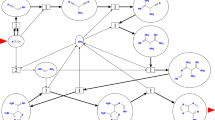Abstract
We define catalytic networks as chemical reaction networks with an essentially catalytic reaction pathway: one which is “on” in the presence of certain catalysts and “off” in their absence. We show that examples of catalytic networks include synthetic DNA molecular circuits that have been shown to perform signal amplification and molecular logic. Recall that a critical siphon is a subset of the species in a chemical reaction network whose absence is forward invariant and stoichiometrically compatible with a positive point. Our main theorem is that all weakly-reversible networks with critical siphons are catalytic. Consequently, we obtain new proofs for the persistence of atomic event-systems of Adleman et al., and normal networks of Gnacadja. We define autocatalytic networks, and conjecture that a weakly-reversible reaction network has critical siphons if and only if it is autocatalytic.
Similar content being viewed by others
References
Adleman, L., Gopalkrishnan, M., Huang, M.-D., Moisset, P., & Reishus, D. (2008). On the mathematics of the law of mass action. arXiv:0810.1108.
Anderson, D. F. (2008). Global asymptotic stability for a class of nonlinear chemical equations. SIAM J. Appl. Math., 68(5), 1464–1476.
Anderson, D. F., & Shiu, A. (2010). The dynamics of weakly reversible population processes near facets. SIAM J. Appl. Math., 70(6), 1840–1858.
Angeli, D., De Leenheer, P., & Sontag, E. D. (2007). A Petri net approach to the study of persistence in chemical reaction networks. Math. Biosci., 210(2), 598–618.
Ceruzzi, P. E. (1981). The early computers of Konrad Zuse, 1935 to 1945. IEEE Ann. Hist. Comput., 3(3), 241–262.
Cox, D., Little, J., & O’Shea, D. (1991). Ideals, varieties and algorithms: an introduction to computational algebraic geometry and commutative algebra. Berlin: Springer.
Craciun, G., Dickenstein, A., Shiu, A., & Sturmfels, B. (2009). Toric dynamical systems. J. Symb. Comput., 44(11), 1551–1565. In Memoriam Karin Gatermann.
Eisenbud, D., & Sturmfels, B. (1996). Binomial ideals. Duke Math. J., 84(1), 1–45.
Feinberg, M. (1972a). Complex balancing in general kinetic systems. Arch. Ration. Mech. Anal., 49.
Feinberg, M. (1972b). On chemical kinetics of a certain class. Arch. Ration. Mech. Anal., 46.
Feinberg, M. (1979). Lectures on chemical reaction networks. http://www.che.eng.ohio-state.edu/~FEINBERG/LecturesOnReactionNetworks/.
Feinberg, M. (1987). Chemical reaction network structure and the stability of complex isothermal reactors–i. the deficiency zero and deficiency one theorems. Chem. Eng. Sci., 42(10), 2229–2268.
Feinberg, M. (1995). The existence and uniqueness of steady states for a class of chemical reaction networks. Arch. Ration. Mech. Anal., 132, 311–370.
Gnacadja, G. (2009). Univalent positive polynomial maps and the equilibrium state of chemical networks of reversible binding reactions. Adv. Appl. Math., 43(4), 394–414.
Gnacadja, G. (2010). Reachability, persistence and constructive chemical networks. Preprint, available at http://math.gillesgnacadja.info/files/ConstructiveCRNT.html.
Gunawardena, J. (2003). Chemical reaction network theory for in-silico biologists. http://vcp.med.harvard.edu/papers/crnt.pdf.
Horn, F. J. M. (1972). Necessary and sufficient conditions for complex balancing in chemical kinetics. Arch. Ration. Mech. Anal., 49.
Horn, F. J. M. (1974). The dynamics of open reaction systems. In Mathematical aspects of chemical and biochemical problems and quantum chemistry, Proc. SIAM-AMS sympos. appl. math., New York, vol. VIII.
Horn, F. J. M., & Jackson, R. (1972). General mass action kinetics. Arch. Ration. Mech. Anal., 49, 81–116.
Hungerford, T. W. (1980). Algebra. New York: Springer.
Miller, E., & Sturmfels, B. (2005). Combinatorial commutative algebra. Berlin: Springer.
Mumford, D. (1988). The red book of varieties and schemes. Berlin: Springer.
Qian, L., & Winfree, E. (2011). A simple DNA gate motif for synthesizing large-scale circuits. J. R. Soc. Interface.
Shinar, G., Alon, U., & Feinberg, M. (2009). Sensitivity and robustness in chemical reaction networks. SIAM J. Appl. Math., 69(4), 977–998.
Shiu, A., & Sturmfels, B. (2010). Siphons in chemical reaction networks. Bull. Math. Biol.
Sontag, E. D. (2001). Structure and stability of certain chemical networks and applications to the kinetic proofreading model of T-cell receptor signal transduction. IEEE Trans. Autom. Control, 46, 1028–1047.
Zhang, D. Y., Turberfield, A. J., Yurke, B., & Winfree, E. (2007). Engineering entropy-driven reactions and networks catalyzed by DNA. Science, 318(5853), 1121–1125.
Author information
Authors and Affiliations
Corresponding author
Additional information
M. Gopalkrishnan’s part of this work was supported by NSF DMS-0943760.
Rights and permissions
About this article
Cite this article
Gopalkrishnan, M. Catalysis in Reaction Networks. Bull Math Biol 73, 2962–2982 (2011). https://doi.org/10.1007/s11538-011-9655-3
Received:
Accepted:
Published:
Issue Date:
DOI: https://doi.org/10.1007/s11538-011-9655-3




